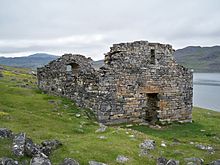European medieval architecture in North America
This article needs additional citations for verification. (June 2020) |

Medieval architecture in North America is an anachronism. Some structures in North America can however be classified as medieval, either by age or origin. In some rare cases these structures are seen as evidence on pre-Columbian trans-oceanic contact. Although much of this is pseudoscience, these buildings are of interest to American scholars of medieval architecture.
Pre-Columbian buildings
- L'Anse aux Meadows, a Norse settlement in Newfoundland. Foundations of eight structures, visible today only as mounds because they were reburied in a conservation effort. Includes modern reconstructions.[1]
- Church of Hvalsey, a Norse church in Greenland. Additional remains of Norse-era settlements.[2]
Transported buildings
Medieval building that have been transported to North America in modern times.
- The Cloisters museum, New York City, a branch of the Metropolitan Museum of Art housed in a complex integrating elements from several different medieval structures
- St. Bernard de Clairvaux Church, a 12th-century cloister from Spain, reassembled in Florida
- Elements of a 12th-century cloister from Saint-Génis-des-Fontaines Abbey, a Romanesque portal, and a 15th-century chapel in the Philadelphia Museum of Art[3]
- Part of a Romanesque cloister in the Toledo Museum of Art, Ohio[4]
- Chapel of St Martin de Sayssuel, (St. Joan of Arc Chapel), Marquette University, Milwaukee, Wisconsin
- Agecroft Hall, Richmond, Virginia[5]
- Chapterhouse of the Abbey of María de Óvila, under reconstruction at the Abbey of New Clairvaux, Vina, California[6]
- A 1524 sidechapel from France in the Detroit Institute of Arts[7]
- A 14th century cloister from France in the Nelson-Atkins Museum of Art[8]
- Parts of Hearst Castle in San Simeon, California
- Parts of Hammond Castle, Gloucester, Massachusetts[9]
- A 12th century Chapter house from France in the Worcester Art Museum, Worcester, Massachusetts[10]
Other later period buildings were also transported like the Cotswold Cottage, built in the early 17th century in Chedworth, Gloucestershire, England, now in The Henry Ford museum in Dearborn, Michigan. The Church of St. Mary the Virgin, Aldermanbury, London, which was designed by Sir Christopher Wren in 1677 is now the National Churchill Museum[11] in Fulton, Missouri. It includes a spiral staircase which probably dates to the 15th century.
Notes
- ^ "L'Anse aux Meadows National Historic Site". Retrieved 15 June 2020.
- ^ "Hvalsey Church ruin". Retrieved 15 June 2020.
- ^ "Cloister with Elements from the Abbey of Saint-Genis-des-Fontaines". Retrieved 15 June 2020.
- ^ "Cloister Section Romanesque)". Retrieved 18 June 2020.
- ^ "Virginia Landmarks Register". Virginia Department of Historic Resources. Retrieved 18 June 2020.
- ^ Bunderson, Carl (January 10, 2013). "California monks build new chapel with medieval stones". Catholic News Agency. Retrieved 7 June 2020.
- ^ "French Chapel". dia.org. Retrieved 6 June 2020.
- ^ "Cloister". nelson-atkins.org. Retrieved 6 June 2020.
- ^ "Hammond Castle Museum". Retrieved 6 June 2020.
- ^ "Chapter House". Retrieved 7 June 2020.
- ^ Sheila M. Hannah (October 1970). "National Register of Historic Places Inventory Nomination Form: Winston Churchill Memorial" (PDF). Missouri Department of Natural Resources. Retrieved 2016-06-06.
